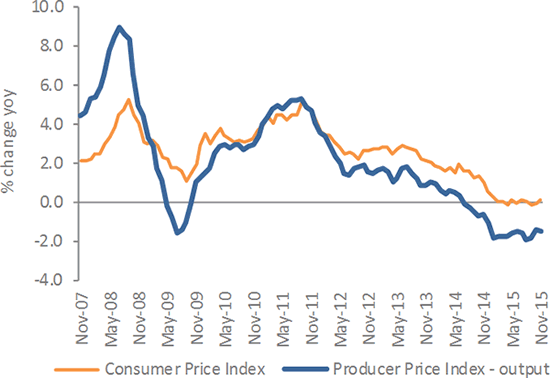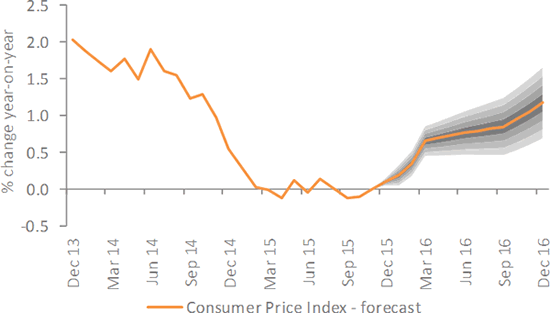Inflation returns in November, the first reading above zero since July
The Consumer Price Index (CPI) returned to inflationary territory in November with prices rising 0.1 per cent, year-on-year – the first reading above zero since July. Movements in transport costs and alcohol and tobacco prices were the main contributors to the rise in the rate. Even through petrol prices are falling now, they fell more sharply this time a year ago meaning headline inflation crept higher. Clothing prices fell by a monthly 0.1 per cent – the first time on record that clothing prices have fallen in November – indicative of the unseasonably warm weather and retailers discounting mid-season. Similarly, punchy falls in alcohol prices a year ago are not being repeated as the supermarket price wars abate, at least a little. A comparison of the CPI against the Producer Price Index for output (PPI), which is indicative of costs faced by retailers, suggests that the sector has managed to maintain gross margins, given a general fall in the cost of goods sold. Given renewed weakness in oil prices, soft commodities and the slowdown in China, we remain confident there will be little upward pressure in the short-run.
1. Costs facing retailers continue to decline
Source: ONSThe rate of deflation across Food and Non-alcoholic drink accelerated in October and fell by 2.7 per cent. The main staples such as Bread (-1.9 per cent), Meat (-3.8 per cent) and Milk, Cheese and Eggs (-6.7 per cent) fell sharply on last year. With real earnings growing at c.2.5 per cent, this will be a welcome boost to household disposable incomes, particularly for lower income households who spend 15.7 per cent of expenditure on food, compared to an average of 11.4 per cent.Despite a return to inflation, the outlook remains weak. The impact of sharp falls in the price of oil last year will begin to fall out of annual comparisons meaning inflation will begin to creep back up. The same is true for the strengthening of the pound this time last year and so we expect imported goods inflation to also begin to rise. However, on the downside, a slowdown in emerging markets continues to keep a lid on global commodity markets and cost pressures. The path for inflation back to the Bank’s target of 2 per cent is expected to be long and protracted. This time a year ago, the consensus estimate had assumed inflation would be 1.75 per cent by now. Over the last 10 quarters, the Bank of England has revised down its forecast of inflation 9 times. We do not expect inflation to reach 1 per cent until the end of 2016 in our central forecast.
2. Outlook for inflation remains weak
Source: Retail Economics analysisBank of England’s forecast puts wage growth at 2.5 per cent by end of 2015, down from 3.0 per cent forecast 3 months ago. Wage growth expected to reach 3.75 per cent y/y by end of 2016. On balance, we believe that this is a continuation of good news for the Bank of England. Inflation does not show any signs of weakening significantly in the short term. Nor does it appear that inflation will rise sharply. This will give the Bank the opportunity to keep to its plan of a gradual rise in interest rates next year.
Back to Retail Economic News